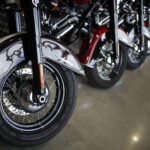A Delta Air Lines Inc. plane slid off a snow-covered runway at LaGuardia Airport in New York last year because the pilots used the wrong technique for slowing down after a landing, U.S. accident investigators concluded on Tuesday.
By adding too much engine power for what is known as “reverse thrust” to help with braking, the crew caused the plane to skid to the left, the National Transportation Safety Board ruled. While other planes landing shortly before had stopped with no issues, the pilots were hampered by outdated runway condition reports and vague guidance in their manuals, the NTSB found.
“Make no mistake: This was a very close call,” NTSB Chairman Christopher Hart said at the hearing in Washington.
The Boeing Co. MD-88 carrying 127 passengers and five crew members slid onto a retaining wall and its nose came to rest over Flushing Bay on March 5, 2015. While no one was seriously hurt, 29 people suffered minor injuries.
Steering Loss
The captain used too much engine power while trying to stop, which can cause a loss of steering on a slick runway, according to NTSB documents. After being told the runway was “good” for braking, he was surprised when he descended through clouds to see that it was covered in snow, he told investigators.
The safety board found that the pilot’s “situational stress” and high work load as he tried to stop contributed to the mistakes.
“The pilots in this accident found themselves without timely and accurate information,” Hart said.
It was unfair to simply cite the crew when they were battling marginal weather conditions and LaGuardia’s relatively short runways surrounded by the bay, said Captain Steve Jangelis, vice president for safety at the Air Line Pilots Association, which represents them.
Morgan Durant, an airline spokesman, said “Delta leaders will use this NTSB guidance to further enhance the safety of our global operation.”
After Flight 1086 came to rest, it wasn’t fully evacuated for more than 17 minutes, surveillance video of the plane showed. Even though firefighters who arrived on scene were urging the flight crew to evacuate because of a fuel leak, the exit was delayed due to poor communication, according to the NTSB. The crash had knocked out the plane’s intercom, making it difficult for the pilots to talk to the flight attendants.
Six Minutes
It took six minutes from the time an evacuation was ordered until the first passenger left the plane. Flight attendants allowed passengers to retrieve winter coats and weren’t urging an immediate exit, the safety board concluded. Evacuations are supposed to occur as quickly as possible in case fire breaks out.
The captain, in landing, used a common technique known as reverse thrust, in which devices within the engines push air forward instead of toward the back of the plane. That helps the brakes slow a plane down.
On the MD-80 series of aircraft, pilots are advised not to use too much engine power during reverse thrust because it can create swirling winds that engulf the tail, where both engines are mounted. If that happens, the tail can no longer keep the plane pointed straight.
The engines on Flight 1086 were revved to higher levels than were permitted in the flight manual, according to the NTSB. The captain told investigators he didn’t look at the thrust setting on the engine after touchdown while concentrating on trying to stop. The copilot noticed the issue and twice told the captain to back off the power, according to NTSB records.
Voice Recording
“Come out of reverse,” the copilot said about eight seconds after landing, according to a transcript of the voice recording. “Come out of reverse.”
As the plane skidded off the runway and onto a retaining wall, the recording captured the pilots uttering several expletives and the sound of rumbling or scraping. The plane stopped about 36 seconds after it first touched down, according to the recording.
Use of too much reverse thrust is common, the NTSB found. In a sample of flights on the accident plane and another Delta jet that had landed just before it, crews used too much reverse thrust in all 14 cases in which runways were wet and skidding was a risk.
Pilot Manual
NTSB board member Robert Sumwalt faulted Delta for not being precise enough in its pilot manuals. They advised pilots that using too much thrust could “potentially” cause skidding, while Boeing documents said it definitely would.
“It’s not a maybe, might, could,” Sumwalt said. “It looks like Delta downgraded this in their training material.”
The accident has some similarities to a fatal runway crash in Little Rock, Arkansas, on June 1, 1999, when an American Airlines MD-82 slid off the airport grounds into an adjacent riverbed in a downpour. Eleven people died when the plane broke apart and a fire erupted.
While it wasn’t the main cause of the accident, the NTSB concluded that a pilot’s attempt to use too much reverse thrust was one reason the plane skidded off the runway.
On Oct. 1, the U.S. Federal Aviation Administration is introducing new standards for describing how slick a runway is in rain, snow or icy conditions. The action is designed to give pilots a clearer sense of the potential risks and it stems from a 2005 crash in Chicago in which a Southwest Airlines Co. plane slid through a fence and hit a passing car outside the airport.
Was this article valuable?
Here are more articles you may enjoy.

 In Fight Over Insurance, Neighbors Crowdsource LA Fire Contamination Data
In Fight Over Insurance, Neighbors Crowdsource LA Fire Contamination Data  EU Adopts Tariffs on $23B Billion of US Goods in Metals Fight
EU Adopts Tariffs on $23B Billion of US Goods in Metals Fight  Trump’s Tariffs Send Deliberate Shock to Heart of Global Economy
Trump’s Tariffs Send Deliberate Shock to Heart of Global Economy  NYC Tourist Helicopter Crashes in Hudson River, Killing Six
NYC Tourist Helicopter Crashes in Hudson River, Killing Six 